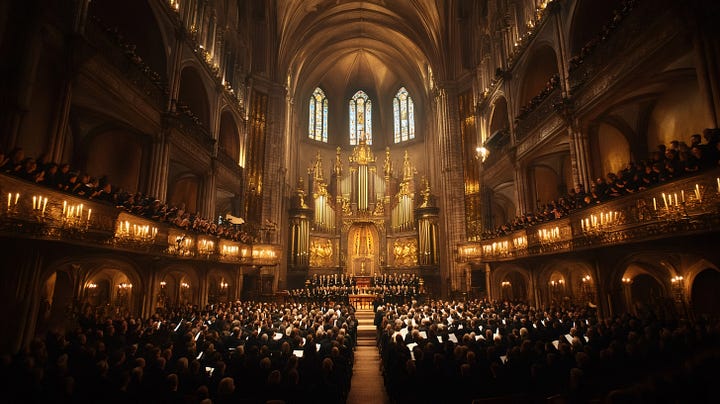Those quaint and ancient gods
we still need them
The Northumbrian landscape near Hadrian’s Wall was hilly and sheared by a northeast wind. I remember standing on the roadway atop the wall, holding my jacket open and catching the wind in such a way that allowed me to lean into the wind at an unnatural angle. I was part of a school group staying at the nearby youth hostel in the village of Once Brewed. This was May of 1973.

Hadrian’s Wall is a huge 73-mile defense wall that was built in 122 AD under Emperor Hadrian to protect the Northern Frontier. It took three legions (about 15,000 men) six years to build.
One of our teacher-guides, a Roman scholar and fluent in Latin, pointed out the humble ruins of the temple of Mithras in the distance. We followed a narrow path across a field. Here our group stood, in the shallow box that was once a house of worship. There are remnants of four Mithraic temples in England; there were hundreds throughout the Roman Empire.
The Roman god Mithras was probably based loosely on the Zoroastrian or Persian deity called Mithra, who according to Wikipedia, had a huge remittance:
Mithra is an ancient Iranian deity of covenants, light, oaths, justice, the Sun, contracts, and friendship. In addition to being the divinity of contracts, Mithra is also a judicial figure, an all-seeing protector of Truth (Asha), and the guardian of cattle, the harvest, and the Waters.
Before learning about Mithras on that windy day, I was familiar with the standard Roman panoply of gods and goddesses, each with their specialized purview. Everyone I knew had read about them in junior high from Edith Hamilton’s Mythology — you know, Jupiter (sky and thunder), Juno (marriage and childbirth), Mars (war), Venus (love, beauty), Minerva (wisdom and strategic warfare - odd portfolio…), Neptune (sea), Apollo (sun, music, prophecy), Diana (the hunt, the moon), Vesta (hearth, home, family), Mercury (commerce, travelers).
But wait, there’s more. Emperors were themselves deified and worshipped as gods — such as Divus Augustus and Divas Trajan. And Mithras was one of many Eastern cults that were also in currency during Hadrian: Isis (magic, motherhood), Serapis (healing, afterlife), Dionysus (wine, ecstasy, theater), and Sol Invictus (who hung out with Mithras) to name a few.
Mithraism was very popular amongst Roman soldiers from the 1st to the 4th century. Some scholars consider it to have been the main competitor to Christianity during that time.
Since that tour of Hadrian’s Wall I have often thought about ol’ Mithras and all those gods and goddesses that had temples built to honor them, constellations named after them, and stories told about them that helped give meaning to life and explain the inexplicable. Rome flourished under the watchful eyes of the pantheon for 400 years until, one could argue, the Edict of Thessalonica (380 AD) when Christianity became the official religion of the empire.
It is believed that this Mithraic Temple fell out of use by around 350 AD. Mithraists suffered religious persecution from Christians and the cult was eliminated from the empire by the end of the 4th century. The temple site was for centuries harvested for stones to build other structures nearby.
I can not help but think of those ancient worshippers as quaint, innocent and naive. They did not know what we know now: that there is a single god whose purview is basically everything: universe, life on earth, humanity. Everything. All topics. One-stop shop. It just seems…right. Our father who art in heaven. Jupiter hurling thunderbolts seems a childish concept. Did they really believe all that stuff about appeasing gods, trying to figure out why they are angry, coming up with rituals to curry favor, invoking a diety specializing in the issue at hand?
We don’t do anything like that these days. We know these gods don’t exist; we call their stories “myths.” We refer to Mithraism as a “cult.” I guess once you have the way, the truth, and the light, there is no space remaining for dissent. We cast off our childish ways. Monotheism seems, at least in the West, monolithic.
Imagine worshipping a group of huge disembodied beings who live in the clouds on a mountain. Who have secret and special power over our lives. Where we depend on their wellbeing and positive disposition toward us. Where society and the body politic approach them beseechingly with gentle requests and appeasements. Where we praise them and all they do for us out of their infinite beneficence.
Sounds a bit nonsensical, right? If we worship, we worship God, Yahweh, Allah in a proper church, temple or mosque following the rituals accorded to each.
But hang on. Is it the pantheon of businesses and corporations that now receive something akin to worship?
We just don’t call it worship.
At the risk of stating what is obvious to any Capitalist, here are a few connections I see:
Tax breaks and subsidies given to businesses are like ritual offerings to curry favor. The blessings bestowed include job creation, investment and growth.
Apple Park, is a kind of Mount Olympus. Each Apple Store is a temple where adherents flock to view and touch the latest technology we depend on.
A corporation moves to a region and brings with it jobs, economic growth, and prestige. On the other hand, when GM closed its Lordstown, Ohio plant in 2019, the economic loss was huge. Economic instability can seem like the plagues of old.
Priests served as intermediaries between people and the gods. Who interprets corporate “will” and influences decisions in this world? Lobbyists and think tanks come to mind.
Many corporate statements — on mission, vision, values and ESG commitments (Environment, Society and Governance) — are the sacred texts. However, these texts are mutable — which we will see when, for instance, EPA constraints are lifted.
We count on the power and influence of different companies for different needs: one for Goods (Amazon), another for Connection (Apple), one for Knowledge (Google), etc.
I think back to Hadrian’s Wall. It was no trivial undertaking. The northern extent of a mighty empire needed demarcation and enforcement to keep out the Picts or whoever lived north of the wall. It is not inconceivable that the hearts of those outpost soldiers were enlivened by the rituals of Mithraism, or the thoughts of greater powers beyond that of the empire.
Sol Invictus, the “Unconquerable Sun,” was promoted as the chief god of the Empire by Aurelius around 274 AD, and held the top slot until Constantine I legalized Christianity. These gods, these forces larger than ourselves — maybe at their best they really do hold things together, and we need them to be on our side of the proverbial wall.







Quaint. Aren't we funny, we humans? Always thinking ourselves more advanced than the last round of funny humans? I appreciate the parallels here, Stew. Well, "appreciate." This must have been some trip for you as student. Not sure I get the Once Brewed/Twice Brewed, but I think it would be fun to map out a travel itinerary to all the places in the world with seemingly oddball names like that. Maybe there's an app for that!
The photo pairing at the end. Oof!